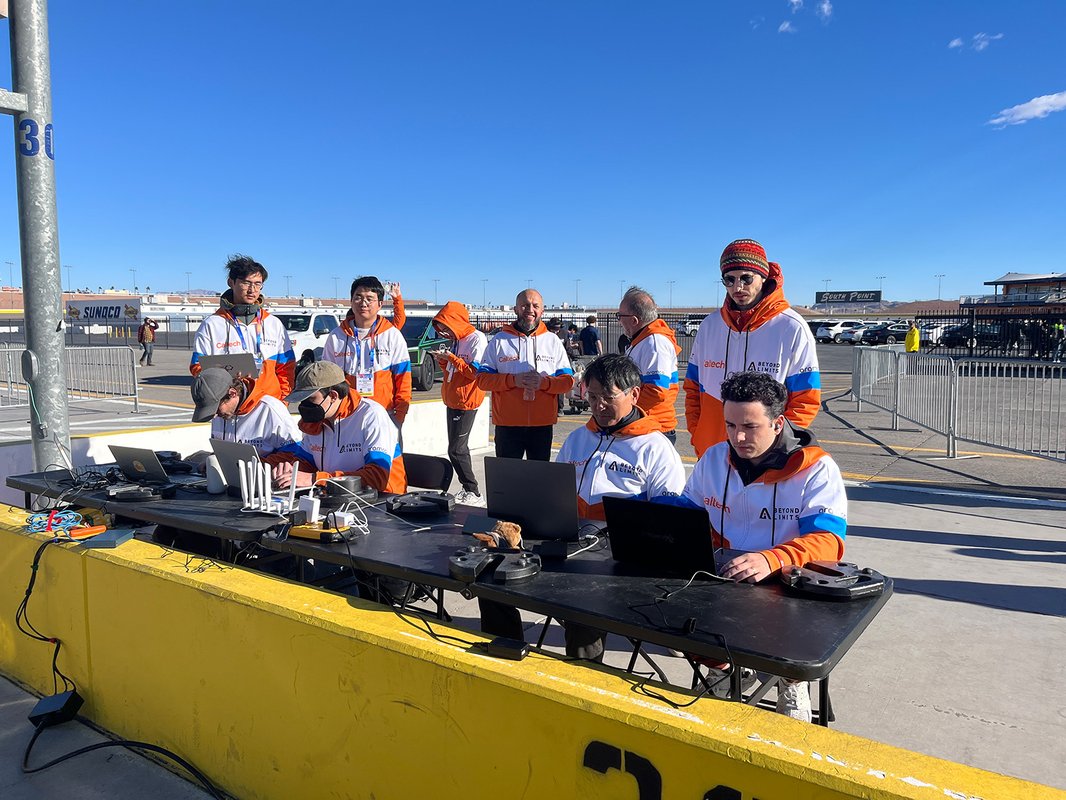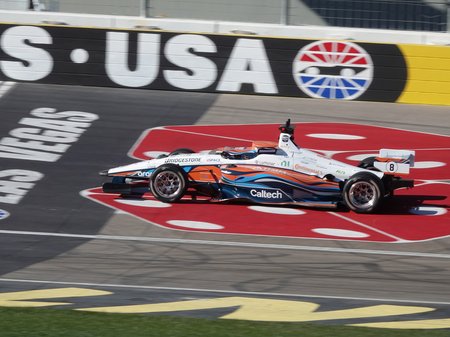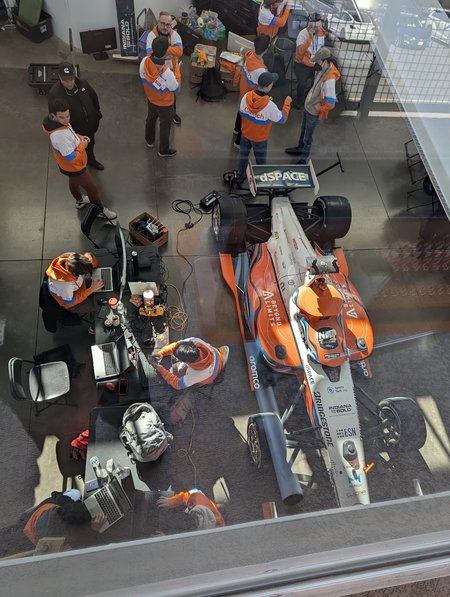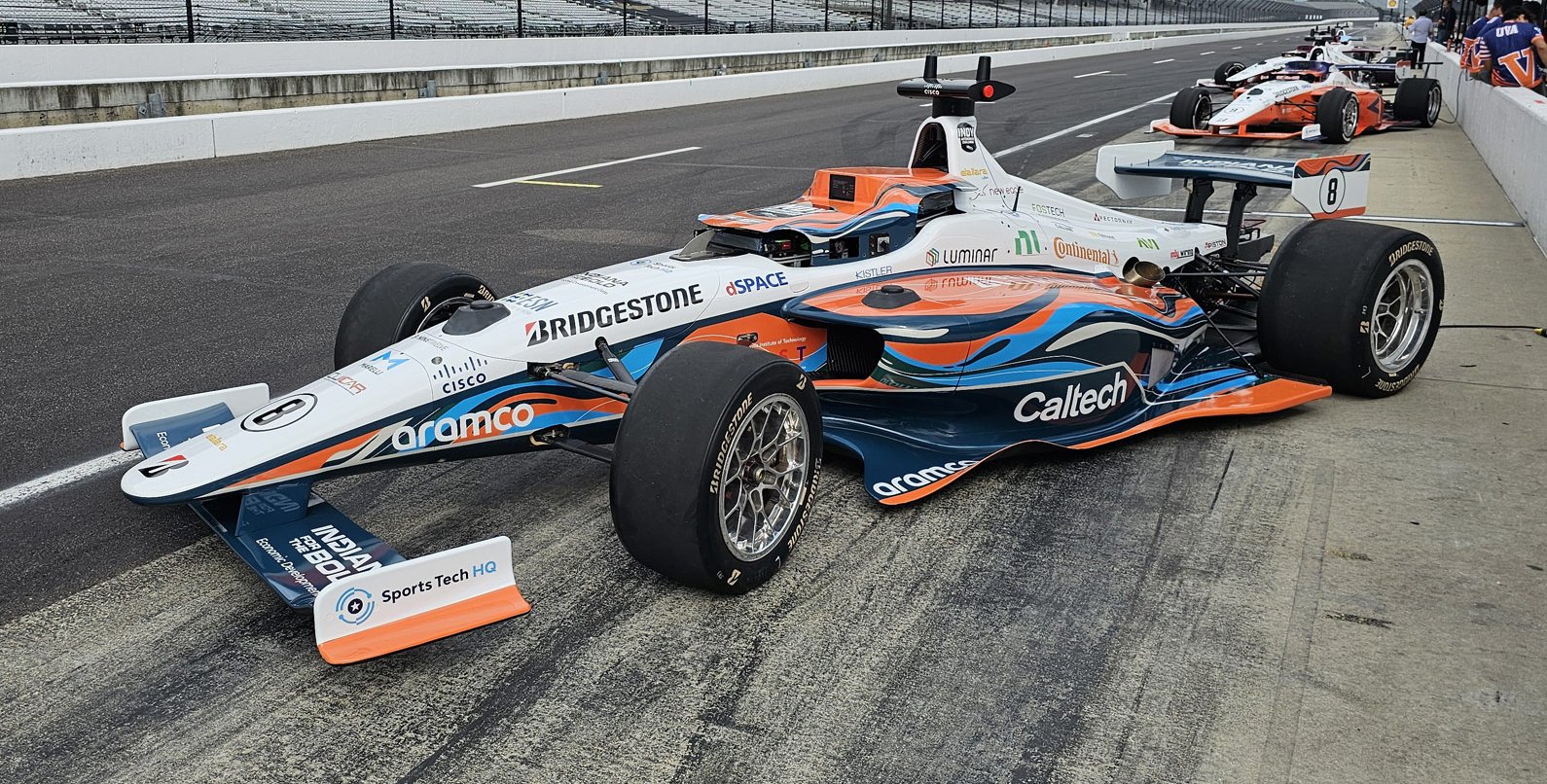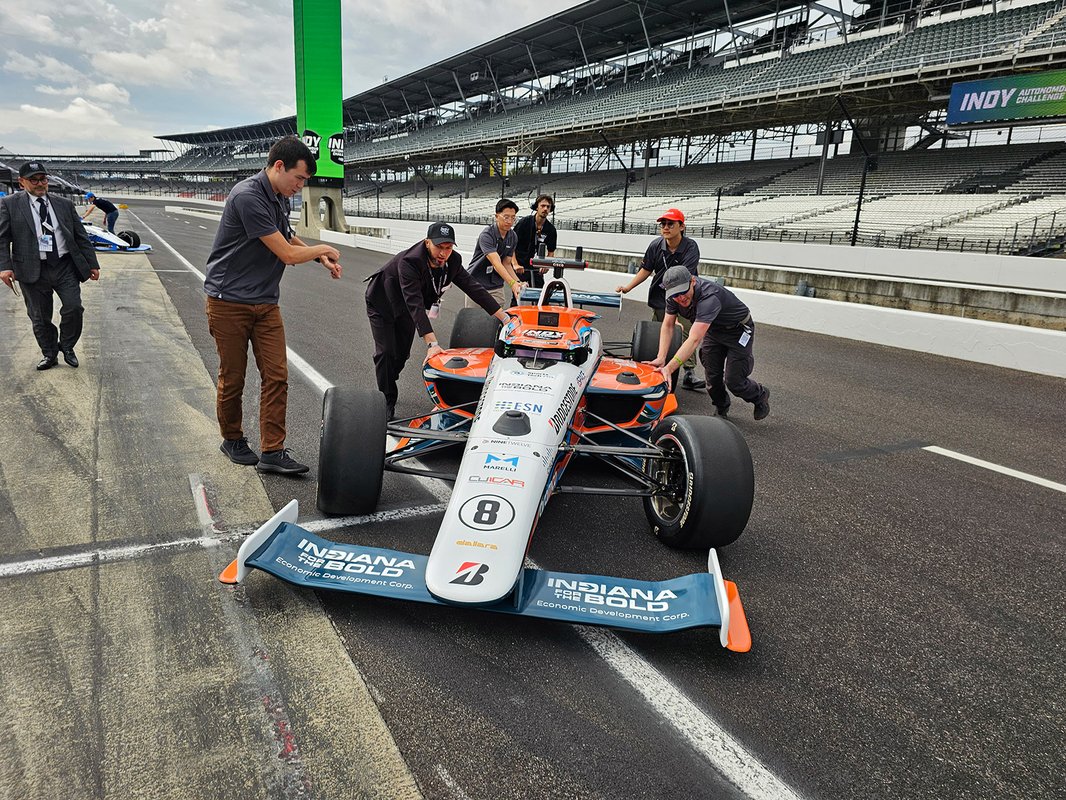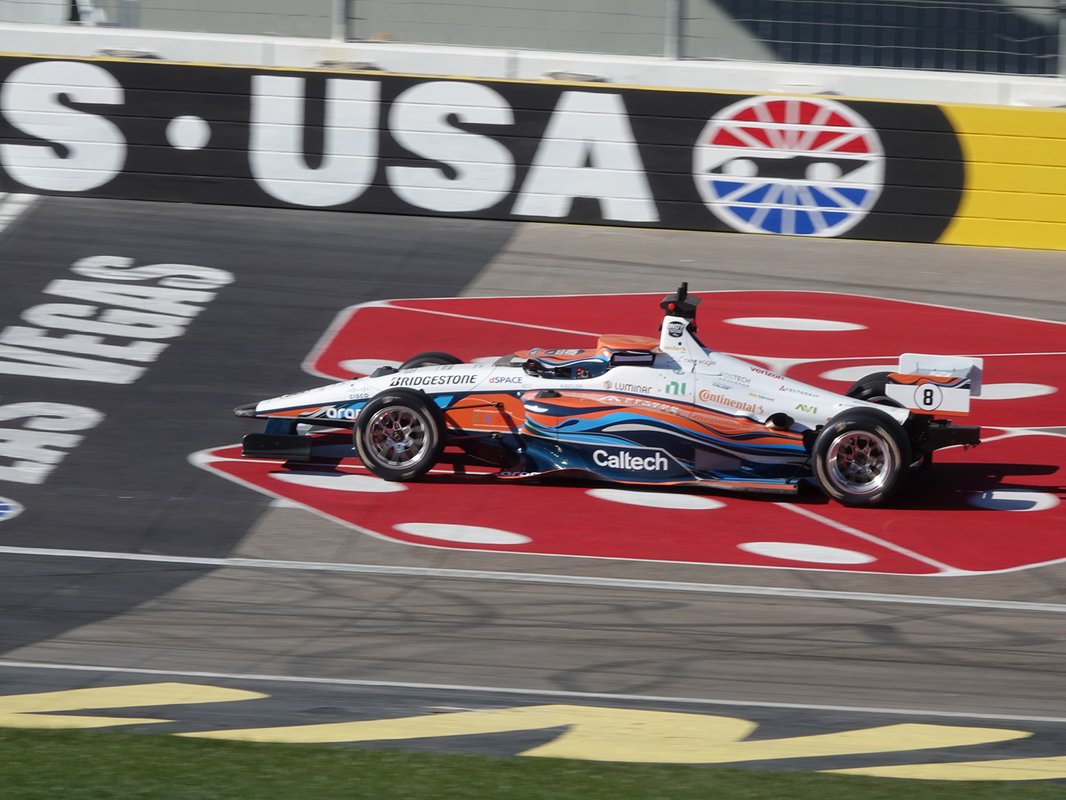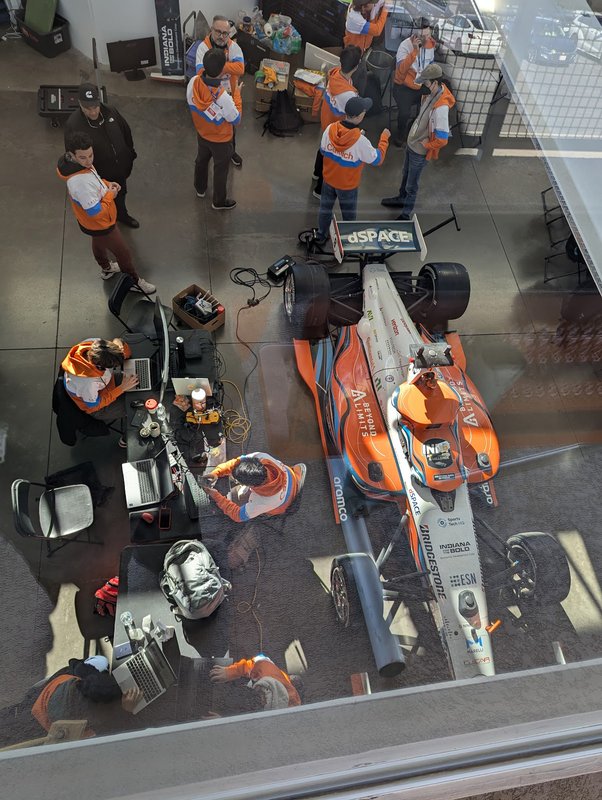In the days leading up to this year's IndyCar Java House Grand Prix of Monterey, eight race cars sped around one of the most famous road courses in the United States: the WeatherTech Raceway Laguna Seca. But there were no celebrity drivers in the cockpits. These were self-driving, autonomous vehicles programmed by university teams and aided by AI, whipping around curves and flying down Laguna Seca's straightaways, sometimes at speeds approaching 150 mph. The newest team of the bunch, the Caltech Racer, laid down what commentators described as an aggressively fast performance.
The July 24 event was part of the Indy Autonomous Challenge (IAC), an ongoing multiyear effort kicked off in 2019 by Indianapolis-based nonprofit Energy Systems Network "to challenge university students around the world to imagine, invent and prove a new generation of automated vehicle software to run fully autonomous racecars and inspire the next generation of STEM talent," according to the IAC website.
There are now 10 active teams in the challenge, representing universities and public–private partnerships from around the world. The IAC supplies each team with a "drive-by-wire" IAC AV-24 car complete with a suite of sensors. The big difference from team to team lies within their computing stacks—the advanced control and autonomy algorithms and intelligence systems run by computers that give the race cars the ability to perceive the novel environment and make decisions about things like acceleration, braking, and navigation as they tear around a track.
Caltech joined the challenge in July 2024, received its car in September, and made its racing debut at an IAC race at CES (Consumer Electronics Show) in Las Vegas in January 2025. The team is comprised of more than a dozen students, staff, and faculty members, as well as research scientists from NASA's JPL, which is managed by Caltech, and has benefitted greatly from the technical contributions of one of its funding organizations, Beyond Limits.
For Caltech, the project started as one of the latest initiatives of the Institute's Center for Autonomous Systems and Technologies (CAST). Engineer Soon-Jo Chung leads the project with former CAST director Mory Gharib (PhD '83), and Fred Hadaegh, research professor in aerospace at Caltech. CAST has a track record of building systems that push the frontiers of autonomous control, having developed robotic systems including flying ambulances and multimodal robots as well as control systems such as one designed to keep damaged unmanned aerial vehicles aloft and another to help spacecraft correct themselves in emergency situations.
Hadaegh, who is also a former JPL chief technologist, says it has been thrilling to see Caltech launch CAST and to take steps toward building intelligent, resilient systems. "For years, we dreamed of machines that could adapt on their own. Now, that dream is real," he says. "We've developed and tested the ability to detect, diagnose, and autonomously recover from failures in real-time—even in the midst of competition—on unmanned vehicles, without human intervention. This is not automation; it is genuine autonomy."
Chung, Caltech's Bren Professor of Control and Dynamical Systems and a senior research scientist at JPL, explains that the IAC is the ultimate test bed for the kinds of algorithms his group develops. "The guiding philosophy of my group is really to balance between theory and practice," he says. "When we develop a new method of autonomous planning or perception-based navigation, for example, we want to make sure those algorithms can be validated in the real world. Autonomous racing provides a realistic controlled environment where students and researchers can test and then improve their methods. Once you have that high speed, it's going to amplify whatever challenges you have—that's very unpredictable. It's a good motivation for us to think about what kind of gap we have between what we do in the laboratory and what we need in real-world settings."
Gharib, who is also the Institute's Hans W. Liepmann Professor of Aeronautics and Medical Engineering, adds that the IAC project represents an exceptionally demanding challenge. "IAC serves as a proving ground for Caltech graduate students to demonstrate their technical expertise, problem-solving capabilities, and unwavering perseverance," he says.
The Scene at Laguna Seca Raceway
The July competition was the first IAC event on a US road course rather than a regular, oval track. (Two previous events have been held on the Monza F1 Circuit in Italy, which is also a road course.) The WeatherTech Raceway Laguna Seca is known as one of the world's toughest courses, with an infamous left turn dubbed "The Corkscrew," which involves a five-and-a-half-story drop in less than 500 feet of track. In addition to such drops and hard turns, the cars in the competition also had to contend with pedestrian bridges in multiple spots throughout the course—features that caused the autonomous vehicles to turn to clever prediction models as they briefly lost the GPS signals that otherwise help them navigate.
During the time trials, one team at a time would signal its car to enter the track with a push of a button. From that point onward, each vehicle was, essentially, on its own to run the race. After one warm-up, the "out lap," the vehicles could spend up to 12 minutes trying to outpace their competitors by clocking the fastest single lap around the 2.238-mile circuit. Meanwhile, the operating team could only send their car simple commands to adjust settings during the final straightaway at the end of each lap—a window that lasted 10 seconds, at most.
But Thomas Berrueta, a postdoctoral scholar in Chung's Autonomous Robotics and Control Lab and Caltech Racer's team lead, explains that by the time the team arrived at the paddock on race morning around 5:30 a.m., everything had "more or less" been determined. "Our code is in place. We've tested it in thousands of simulations. We've tested it on the hardware at the track. We've decided on a race strategy," he says. "There's this overall silence in the air that just hangs as you're waiting for the moment that you're called to the control center to actually run your race."
On race morning, the orange, white, and light blue Caltech Racer (with two stuffed animals riding on top: a beaver and a Pokémon Psyduck) was the sixth to run its time trial based on the team's strong performance in qualifying runs. Berrueta and two other team members sat in the control center, staring at spreadsheets that specified the car's preprogrammed race routine and analyzing live telemetry feeds from the vehicle. Other teammates watched the vehicle from pit lane, making sure it was working as expected. Berrueta pushed what he described as a launch button, and Caltech Racer was off, following what was designed to be an aggressive race plan.
"The race plan on my laptop effectively consists of a series of race lines, or specifications for behavior that the car should try to follow on a per-lap basis," Berrueta says. "The car deviates from these specifications, moment to moment, all the time, but they guide its overall behavior."
"One important aspect of this race is that when you increase the speed on the corners, that's going to put the car at the edge of its traction and friction limits, and if you exceed that, it's going to skid or spin out," Chung explains. "So, it's a tradeoff: You want to maximize the cornering speed while you make sure the car is safe and doesn't skid too much. We really pushed the envelope in terms of what our autonomy technology could safely achieve."
Indeed, by being aggressive, the Caltech Racer demonstrated the fastest first and second lap times seen in the competition up until that point. Unfortunately, the car spun out on the third lap in the dreaded "Corkscrew" and hit a wall. That drew a red flag that, according to race rules, meant dropping Caltech's two fastest laps.
In the end, PoliMOVE MSU, a team from Michigan State University and Italy's Polytechnic of Milan, claimed first place, Purdue University took second, and Korea Advanced Institute of Science and Technology finished third.
Though disappointed by the final outcome, the Caltech team was encouraged by its first couple of laps and is working with the data from the race to refine its methods.
"The Caltech team has achieved remarkable progress—advancing solutions to challenges that have taken other institutions years to address—and continues to push the frontier of autonomous vehicle innovation," Gharib says.
Race officials and commentators also took note of the team's progress.
"Look at Caltech," said announcer Shea Adam during the event's telecast. "They had a car that was way, way, way competitive. They are somebody who I would expect to be right there, thereabouts, for the win at the next competition that we have."
"I think we saw some great performances today from some of our teams," said Paul Mitchell, president and CEO of IAC and Energy Systems Network, during the awards ceremony following the race. "This competition has 10 teams that are incredibly dedicated. And at any point in time, these teams can jump the ladder. … There really were some outstanding laps that were being run by the team from Caltech—our newest team. So, really great progress is being made."
An Important Stack at the "Wheel"
Heading into the competition, the Caltech car had driven more than 1,200 miles in 2025—hundreds more than the team that had logged the second-most miles. But beyond "practice makes progress," what differentiates one autonomous race car from another? After all, each IAC car has the same four Bridgestone Racing Slick tires, the same modified IndyNXT chassis and engine, and the same CPU (Central Processing Unit) and GPU (Graphics Processing Unit) crunching data from the same suite of sensors. Those include six color cameras, two radar sensors, GPS sensors, and four LiDAR (Light Detection and Ranging) sensors that use lasers, rather than radio waves as in radar, to create 3-dimensional maps of a vehicle's surroundings.
In the cockpit, where the driver of an IndyCar would normally sit, each autonomous vehicle instead houses a huge computer. That computer runs the team's software stack—a combination of its motion planner, which can be thought of as "the brains" of the vehicle, and the tracking controller, the software that sends commands to the car's actuators that make the car speed up, slow down, turn, etc.
To understand what the stack aims to accomplish, consider one of the skills that the best human race car drivers have refined: The ability to sense how their car's tires are interacting with the road at any given moment. Drivers know when to push their car harder versus when they need to ease up based on their intuition, or "feel," for the car's performance. Imbuing an autonomous car with something like that intuition is extremely challenging and requires a sophisticated model, essentially a set of equations, that describe the physical limitations of the tires. This model is constantly updated based on what the robotic vehicle is experiencing.
Berrueta explains that the Caltech Racer's motion planner is continually constructing estimates of how far the car's components can be pushed. For example, he says, as the car goes around a corner, it will calculate and then recalculate how fast it can travel without spinning out. "It's developing a nuanced understanding of just how much the tires can bear in different conditions. At the same time, it's designing a plan so that the tracking controller can bring those constraints to life."
"The faster we go, the more complicated the physics get, and the harder it is to model accurately," says Nikhil Ranganath (MS '20), a graduate student in Chung's lab and a member of the Caltech Racer team. "The underlying challenge is that the car, in order to go as fast as possible, is always butting up against our own uncertainty of the model's parameters."
That uncertainty is always there because conditions are constantly changing. For example, he says, the buildup of wear and tear on the tires over the course of a single race will change the car's ability to grip the road. Even factors such as dust accumulating on the tires or the temperature or humidity of the raceway will alter the car's performance.
"There are so many tiny little things that can happen that have an impact on your understanding of what your tires can do that it's very challenging to have a truly correct model," Berrueta says.
Being Aggressive, With Safety in Mind
And the consequences of an incorrect model can be dire for these million-dollar vehicles. If the car loses grip or a wheel locks, as it did in "The Corkscrew" at Laguna Seca, it can spin out and crash.
"One of the primary challenges of this project is that you are really trying to push to be fast, but at the end of the day, you're working with a real car that's around real people, and you have to make sure to keep the thing safe," says Ranganath. "One thing that you learn in the process of doing field robotics is how to approach aggressive development while simultaneously building a system that is safe by design."
That is why, the team says, autonomous racing is such a fascinating proving ground for robotic algorithms. Not only does the car's code have to run smoothly and at breakneck speeds, but performance and safety are simultaneously nonnegotiable. If the team sacrifices a bit of performance to be extra cautious, the car could easily lose the race.
And because autonomous systems are on the rise throughout society, the development of these algorithms is directly relevant to any number of other applications—from the operation of oil rigs and self-driving cars to the control of distant spacecraft. "Autonomy is everywhere in our society," Berrueta says. "There are no limits truly to where rapid response to failure and changing conditions will apply."
A Strength in Rapid Online Adaptation
The Caltech Racer team has learned much in the year since it joined the IAC competition last fall. Though none of the team members ever expected to be working in autonomous racing, they are thrilled to be involved in the challenge.
"It is exceedingly rare in research that you get to work on something that is so directly applied, with such concrete, real-world consequences," Berrueta says. "When I make a mistake in one line of code, my car might crash. The way in which your work has a direct physical impact that is irreversible in some ways is rare for a research project. Normally we don't work with platforms that are this challenging, expensive, and specialized."
Looking to future IAC events, the team says they are enhancing the way machine learning is integrated into the race car's motion planning, control, and perception, making it more adaptive and reactive to real-time track conditions, such as the temperature of the tires or dust on the track.
All in all, Hadaegh says the chance to bring genuine autonomy to race cars is extraordinary. "These platforms demand speed, precision, and resilience in the face of uncertainty—and now we can deliver. The IAC has provided us with the perfect stage to demonstrate our autonomy and prove that onboard technologies are not just concepts, but breakthroughs with real-world impact. This is where the future of autonomy is being written—boldly, and in real time."
The Caltech Racer team is funded by Beyond Limits, a Caltech/JPL spinoff company, through a partnership with Aramco.
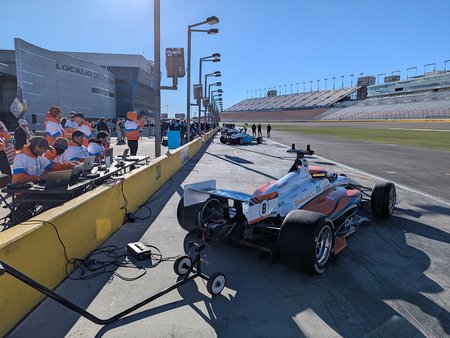 A team of Caltech graduate students, postdoctoral scholars, faculty members, and JPL research scientists has worked to get the Caltech Racer, a self-driving race car, up and running at competitive speeds in the Indy Autonomous Challenge. Team members and the racer are shown preparing for the car's debut event, a time trial at CES 2025 in Las Vegas.
A team of Caltech graduate students, postdoctoral scholars, faculty members, and JPL research scientists has worked to get the Caltech Racer, a self-driving race car, up and running at competitive speeds in the Indy Autonomous Challenge. Team members and the racer are shown preparing for the car's debut event, a time trial at CES 2025 in Las Vegas.
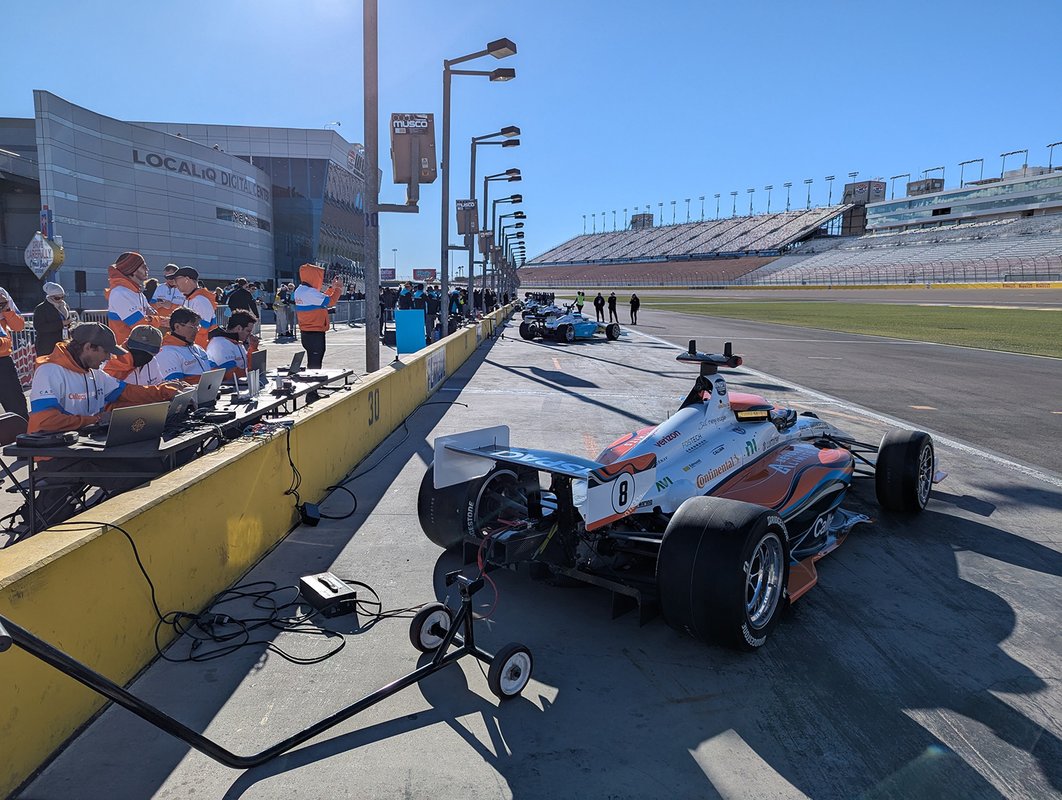
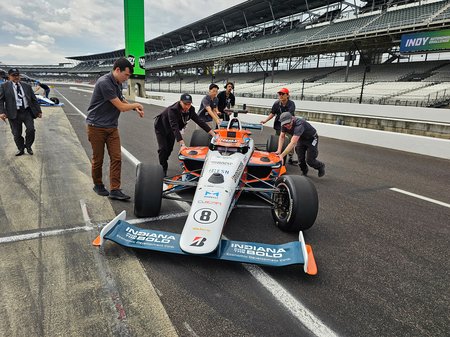
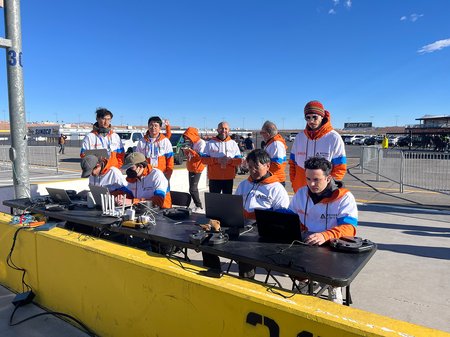 The Caltech Racer team checks that everything is ready to go on race day at the IAC competition in January.
The Caltech Racer team checks that everything is ready to go on race day at the IAC competition in January.
